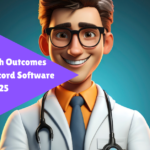In 2025, the Indian healthcare industry is undergoing a massive digital transformation. Thanks to the rise of medical software, hospitals, clinics, and even small health centers are now equipped with tools to streamline patient care, improve accuracy, and offer better experiences.
With government programs like Ayushman Bharat Digital Mission (ABDM) leading the push for digital health, medical software in 2025 isn’t just a trend—it’s the future of Indian healthcare.
For more information, you can also visit the Kiddoklinik site!
Ready to take the first step?
We’ll assist you through every step.

Types of Medical Software in 2025
1. Electronic Health Records (EHR)
Digitally stores patient history, prescriptions, vaccination records, allergies, and lab results.
2. Hospital Management Software (HMS)
End-to-end solution managing OPD, IPD, billing, labs, pharmacy, and inventory.
3. Telemedicine Platforms
Allow virtual consultations, remote monitoring, and e-prescriptions.
4. Diagnostic Lab Software
Automates test results, sample tracking, and reporting.
5. Billing and Insurance Software
Automates insurance claims and revenue cycle management.
6. Prescription Software
Allows quick, digital prescription generation and pharmacy coordination.
What is Medical Software?

Medical software refers to any application or digital tool that helps healthcare providers with clinical, administrative, or diagnostic tasks. It includes systems like:
- Electronic Health Records (EHR)
- Hospital Management Software (HMS)
- Telemedicine platforms
- Medical billing and insurance software
- Diagnostic and lab software
- Prescription and pharmacy tools
In 2025, these solutions are cloud-based, AI-driven, and designed to be mobile-friendly and multilingual—ideal for a diverse country like India.
Why Medical Software Is Crucial in 2025?
Here’s why medical software is more important than ever in today’s healthcare setup:
1. Rapid Urbanization and Patient Load
With growing urban populations, doctors need tools to manage high volumes of patients efficiently.
2. Health Data Digitization
India’s push for ABHA Health IDs requires clinics and hospitals to maintain digital records.
3. Telemedicine Boom
Post-COVID habits continue in 2025, with rural areas increasingly using teleconsultation apps for access to specialists.
4. AI-Powered Healthcare
AI is now integrated into diagnostics, treatment recommendations, and patient monitoring.
Benefits of Using Medical Software in 2025
| Benefit | How It Helps |
|---|---|
| Faster patient care | Quick access to records, test results, and history |
| Improved accuracy | Reduces prescription errors and misdiagnosis |
| Remote access | Cloud-based systems accessible via phone or tablet |
| Cost savings | Lowers operational costs and paper usage |
| Better communication | Patients get reminders, updates, and online reports |
Government Role: ABDM & Digital Health Push
The Ayushman Bharat Digital Mission (ABDM) has made it easier for software providers to create interoperable tools. By 2025:
- Over 40 crore Indians have registered for ABHA health IDs
- Clinics are connecting with NDHM-compliant software
- Health data privacy laws are being introduced for secure patient information management
This means software now comes pre-equipped with ABDM integration, ensuring seamless digital records, even if a patient visits multiple hospitals.
Indian Medical Software Trends in 2025
1. Voice-Enabled Software
Doctors now dictate notes using voice recognition, especially in regional languages.
2. AI-Based Predictions
AI tools flag high-risk patients, suggest diagnoses, and optimize treatment.
3. Wearable Integration
Patient data from wearables (like FitBit, Apple Watch) feeds directly into their EHR).
4. Multilingual Dashboards
Software now supports Hindi, Tamil, Bengali, and more to increase accessibility.
5. Offline Mode
For rural and low-connectivity areas, many platforms offer offline functionality with sync options.
Challenges in Adopting Medical Software
Despite progress, some challenges remain:
| Challenge | Solution |
|---|---|
| Lack of tech skills | Training modules, easy UI |
| High cost | Subscription-based or freemium models |
| Internet dependency | Offline support and hybrid systems |
| Data security | Strong encryption, HIPAA/NPD compliant software |
How to Choose the Right Medical Software?
- Assess Needs: Clinic size, specialty, and patient load
- Check for ABDM Compliance: Especially for insurance and digital records
- Try a Free Demo: Always test before buying
- Customer Support: Choose companies with local support and training
- Scalability: Ensure the software grows with your practice
Top 5 Medical Software Companies in India (2025)
| Software | Key Features | Suitable For |
|---|---|---|
| KidsCur | Pediatric EHR, vaccine tracking | Child clinics |
| HealthPlix | AI-based EHR, multi-language | General physicians |
| MocDoc | Full hospital suite | Multi-specialty hospitals |
| Practo | Teleconsultation + CRM | Small clinics & OPDs |
| CrelioHealth | Diagnostic automation | Labs and imaging centers |
Conclusion
In 2025, medical software is no longer optional—it’s essential. From improving patient experience to complying with national digital health programs, these tools are changing how Indian healthcare functions.
Whether you’re a pediatrician in Delhi, a general physician in Lucknow, or managing a multi-specialty hospital in Bangalore, adopting the right medical software will help you provide faster, smarter, and safer healthcare.
FAQs
1. Is medical software affordable for small Indian clinics?
Yes, many Indian startups offer subscription-based models and free trials that work well even for single-doctor clinics.
2. How secure is patient data in cloud-based software?
Reputable Indian medical software uses encryption, user access controls, and follows ABDM and global data security standards.
3. Can medical software work in rural areas?
Yes, several platforms now offer offline capabilities and sync options for low-internet zones.



